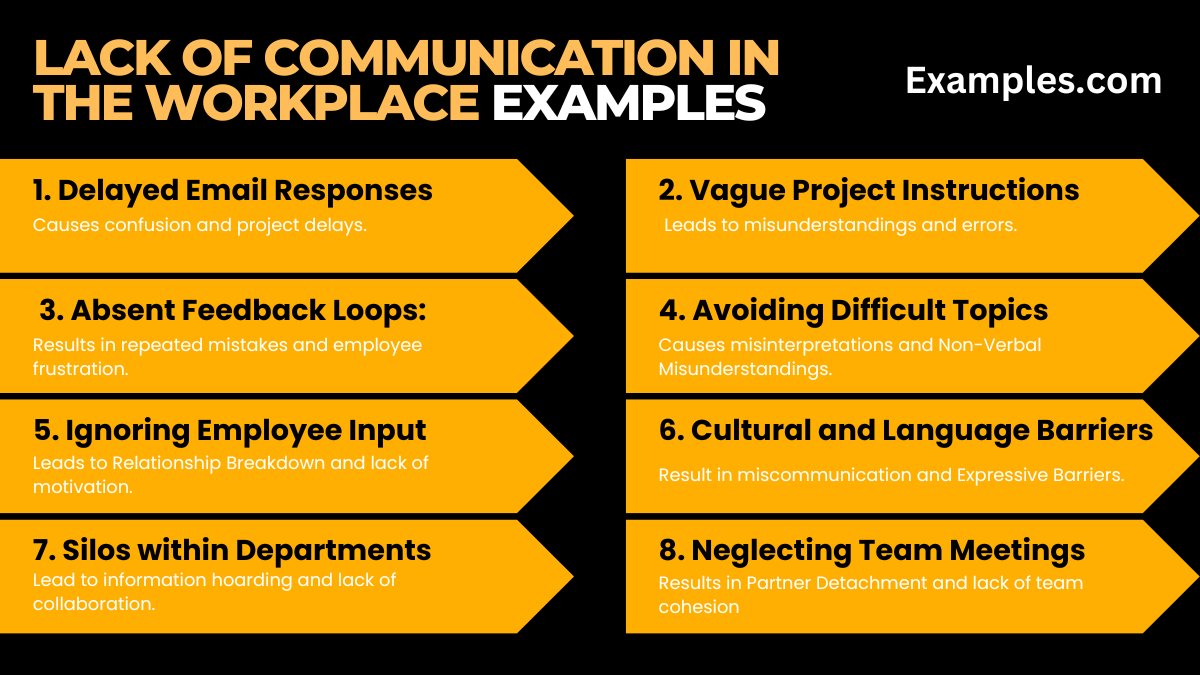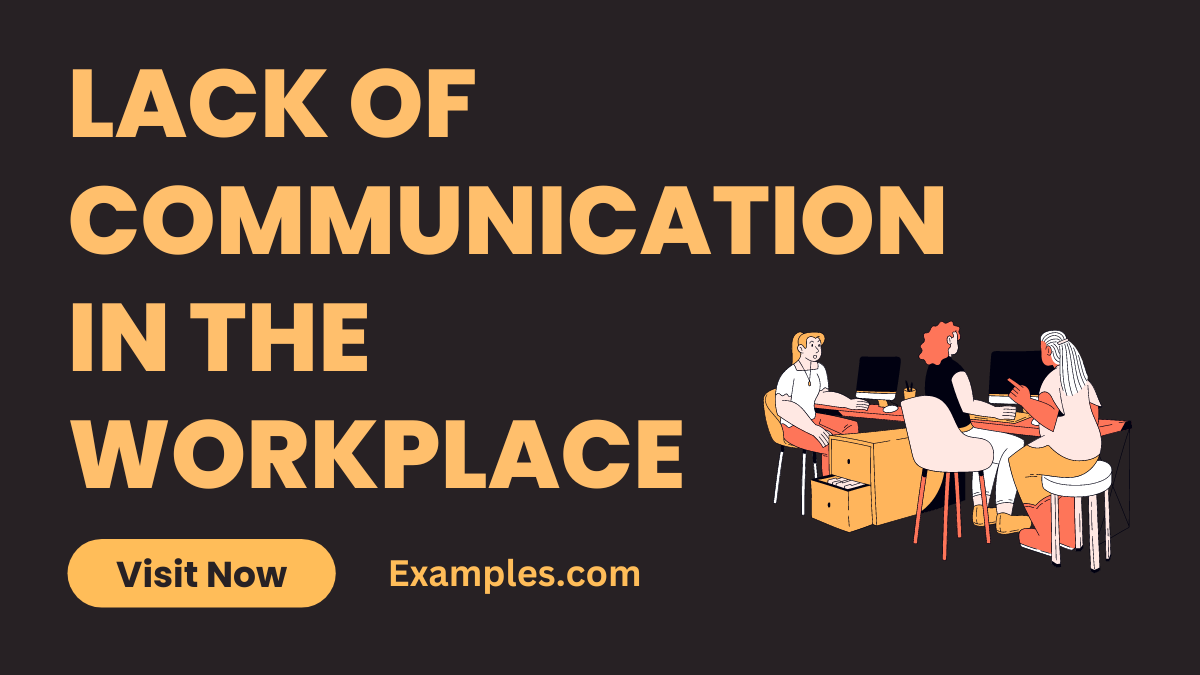50+ Lack of Communication in the Workplace Examples
Dive into the complexities of Lack of Communication in the Workplace with our in-depth guide, featuring real-world communication examples. This guide sheds light on the subtle yet profound impact of communication gaps in professional environments. From identifying early signs of miscommunication to exploring practical solutions, we provide insights into transforming workplace communication, fostering a more collaborative and productive atmosphere.
What is Lack of Communication in the Workplace?

Lack of communication in the workplace occurs when there is insufficient, unclear, or no exchange of information among colleagues, leading to misunderstandings, reduced efficiency, and potential conflict. It can manifest in various forms such as missed emails, unclear instructions, or absence of feedback, impacting overall workplace harmony and productivity.
10 Lack of Communication in the Workplace Examples

In the intricate dynamics of workplace interactions, Lack of Communication often leads to challenges that can hinder productivity and morale. Our comprehensive guide delves into the Lack of Communication in the Workplace, addressing its subtle yet profound effects on professional environments. Featuring Lack of Communication Examples, we explore how gaps in communication lead to challenges that can significantly hinder productivity and morale thereby fostering a more cohesive and productive work environment.
- Delayed Email Responses: Causes confusion and project delays.
Fix: Establish clear guidelines on email response times. - Vague Project Instructions: Leads to misunderstandings and errors.
Fix: Implement detailed briefings and regular check-ins. - Absent Feedback Loops: Results in repeated mistakes and employee frustration.
Fix: Regular and constructive feedback sessions. - Over-reliance on Digital Communication: Causes misinterpretations and Non-Verbal Misunderstandings.
Fix: Encourage face-to-face or video meetings for complex discussions. - Lack of Transparency in Decision-Making: Triggers Trust Erosion and employee disengagement.
Fix: Share decision-making processes and rationales. - Ignoring Employee Input: Leads to Relationship Breakdown and lack of motivation.
Fix: Create channels for employee suggestions and demonstrate their impact. - Inconsistent Messages from Management: Causes confusion and Conflict Avoidance.
Fix: Unified and consistent communication from leadership. - Cultural and Language Barriers: Result in miscommunication and Expressive Barriers.
Fix: Cultural sensitivity training and language support. - Silos within Departments: Lead to information hoarding and lack of collaboration.
Fix: Cross-departmental meetings and team-building activities. - Neglecting Team Meetings: Results in Partner Detachment and lack of team cohesion.
Fix: Regular, structured team meetings with clear agendas.
Addressing these common communication issues can significantly improve workplace dynamics, leading to a more engaged and efficient workforce.The guide provides real-world scenarios and practical solutions, from understanding Lack of Communication Causes & Reasons to applying strategies to How to Fix Lack of Communication.
Lack of Communication in the Workplace Quote
- “None of us is as smart as all of us.” – Ken Blanchard.

Reasons for Lack of Communication in the Workplace
In the professional sphere, several factors contribute to a lack of communication. In professional settings, Lack of Communication in a Relationship or Lack of Communication in Marriage can mirror similar issues faced in workplace dynamics.Identifying these reasons is the first step towards creating a more communicative and productive work environment.
- Diverse Communication Styles: Different personal communication preferences can lead to misunderstandings.
- Cultural and Language Barriers: Cultural differences and language issues can hinder clear communication.
- Overuse of Digital Communication: Reliance on emails or texts can lead to impersonal and unclear messaging.
- Workplace Hierarchies: Rigid hierarchical structures often restrict open communication.
- Lack of Regular Meetings: Infrequent team meetings can lead to a disconnect among team members.
- Unclear Roles and Responsibilities: Ambiguity in roles can lead to confusion and poor communication.
- Technological Challenges: Inadequate or outdated communication tools can hinder effective communication.
How to Fix Lack of Communication in the Workplace
Addressing communication issues in the workplace involves strategic changes and fostering an environment of openness and Key factors contributing to communication breakdowns include Lack of Communication Skills and Lack of Eye Contact in Communication.clarity.
- Implement Clear Communication Channels: Establish and promote the use of effective communication platforms.
- Encourage Feedback Culture: Create a safe space for employees to share feedback and suggestions.
- Regular Team Meetings: Hold consistent meetings to ensure team alignment and information sharing.
- Training and Workshops: Offer communication skills training for employees.
- Clarify Roles and Responsibilities: Ensure every team member understands their role and its impact.
- Embrace Cultural Diversity: Conduct cultural awareness training to reduce language and cultural barriers.
- Upgrade Technological Tools: Invest in modern communication tools that cater to diverse needs.
Lack of Communication in the Workplace Statistics
Statistical insights into the prevalence and impact of communication issues in workplaces, such as those provided by Queens University of Charlotte in their study on Communicating in The Workplace, can be pivotal in understanding the seriousness of these issues. The guide also highlights the Effects of Lack of Communication in the Workplace, demonstrating the ripple effect of communication gaps on both individual and organizational performance. These statistics and insights underscore the critical nature of effective communication in maintaining a productive and harmonious work environment.
- High Percentage of Workplace Errors: Statistics show that a significant number of errors at work are due to poor communication.
- Impact on Employee Turnover: Studies indicate that communication problems often lead to higher employee turnover rates.
- Effect on Project Delays: A large portion of project delays can be attributed to communication gaps.
- Influence on Employee Engagement: Data reveals a correlation between communication quality and employee engagement levels.
- Cost to Organizations: Financial analyses suggest that poor communication can lead to substantial losses for businesses.
- Impact on Employee Morale: Surveys show that lack of communication negatively affects employee morale and job satisfaction.
- Influence on Innovation: Research indicates that poor communication hampers innovation and creativity in the workplace.
Lack of Communication Between Managers and Employees
Communication gaps between managers and employees can lead to a range of workplace issues, affecting overall organizational effectiveness.We address specific scenarios such as Lack of Communication in Healthcare and the unique challenges it presents, offering insights into how to bridge these gaps.
- Misaligned Goals and Expectations: Often, employees are unclear about management’s expectations, leading to misaligned efforts.
- Feedback and Recognition Gaps: Lack of regular feedback and recognition from managers can demotivate employees.
- Inadequate Support and Guidance: Employees may feel unsupported due to insufficient guidance from managers.
- Decision-Making Exclusion: Employees often feel excluded from decision-making processes.
- Information Hoarding: Managers sometimes withhold information, leading to a trust gap.
- Inconsistent Communication: Inconsistency in messages from management can lead to confusion.
- Lack of Empathy and Understanding: A failure to understand employee perspectives can widen the communication gap.
Causes and Effects of Lack of Communication in the Workplace
Poor communication in the workplace can stem from various sources and lead to a multitude of problems, affecting both the individual and organizational performance. These insights are complemented by thought-provoking Lack of Communication Quotes & Sayings, including Deep Lack of Communication Quotes and Silence Lack of Communication Quotes, which encapsulate the essence of communication challenges.Here are 10 key points highlighting the causes and effects of poor communication:
- Lack of Clear Direction: Without clear instructions, employees may feel confused, leading to errors and inefficiencies in their work.
- Cultural and Language Barriers: Diverse work environments can lead to misunderstandings if cultural differences and language barriers are not effectively managed.
- Technological Challenges: Over-reliance on emails or digital communication tools can result in impersonal interactions and misinterpretations.
- Hierarchy and Power Dynamics: A rigid hierarchical structure can intimidate employees from speaking up or sharing ideas, stifling innovation and team spirit.
- Information Overload: Bombarding employees with too much information can lead to important details being missed or ignored.
- Lack of Feedback Mechanisms: Without regular feedback, employees may continue making the same mistakes, hampering personal growth and organizational progress.
- Silos within Teams: Departmental silos can create gaps in communication, leading to a lack of collaboration and unity.
- Non-Verbal Miscommunication: Non-verbal cues are often lost in digital communication, leading to misinterpretation of the intended message.
- Stress and Workload: High stress and excessive workload can hinder effective communication, as employees might not have the time or mental bandwidth to communicate properly.
- Lack of Personal Interaction: In the age of remote work, the absence of face-to-face interaction can lead to feelings of isolation and detachment, impacting team dynamics.
Each of these points underscores the importance of addressing communication challenges proactively to maintain a healthy and productive workplace environment.Our guide goes beyond identifying problems, offering 10 Key Strategies to Solve Poor Communication in the Workplace.
How to Solve Poor Communication in The Workplace
Addressing poor communication in the workplace is crucial for fostering a productive, harmonious, and efficient work environment. Poor communication can lead to misunderstandings, decreased morale, and hindered progress. Implementing effective strategies can transform the way information is shared and received among team members. Here are 10 key strategies to solve poor communication in the workplace:
- Establish Clear Communication Channels: Create designated platforms for different types of communication, ensuring that important messages are conveyed through the most effective medium.
- Promote Open and Honest Dialogue: Encourage employees to share their thoughts and opinions in a respectful environment, fostering a culture of openness.
- Implement Regular Meetings: Schedule regular team meetings to discuss ongoing projects, address issues, and share updates, ensuring everyone is on the same page.
- Provide Effective Training: Offer training sessions focused on communication skills, including active listening and clear articulation, to enhance overall communication proficiency.
- Encourage Feedback: Create a system where employees can give and receive constructive feedback, helping to identify and address communication gaps.
- Utilize Technology Appropriately: Leverage technology tools like collaboration software and project management platforms to streamline communication, especially in remote work settings.
- Clarify Roles and Responsibilities: Ensure every team member understands their role and responsibilities, reducing confusion and enhancing accountability.
How Do You Address an Employee with Communication Issues?
To address an employee with communication issues, provide constructive feedback, offer support and resources for improvement, and create opportunities for them to practice and enhance their communication skills.
How Do You Overcome Lack of Communication?
Overcoming lack of communication involves actively encouraging open dialogue, providing clear and consistent information, fostering a feedback culture, and using effective communication tools and strategies.
How Does Lack of Communication Affect the Workplace?
Lack of communication in the workplace leads to misunderstandings, reduced efficiency, lower morale, increased errors, and a general decline in team cohesion and productivity.
In sum, Lack of Communication in the Workplace significantly impacts organizational effectiveness, employee morale, and overall productivity. By understanding its causes and implementing strategic solutions, businesses can foster a more communicative, efficient, and positive work environment. The guide concludes with an emphasis on the need for strategic changes to address communication issues, reaffirming that effective communication is key to a productive and harmonious work environment. Whether it’s finding solutions for Lack of Communication in Couples or enhancing communication skills in a professional context, our guide serves as an essential resource for navigating and resolving communication challenges in various aspects of life.



